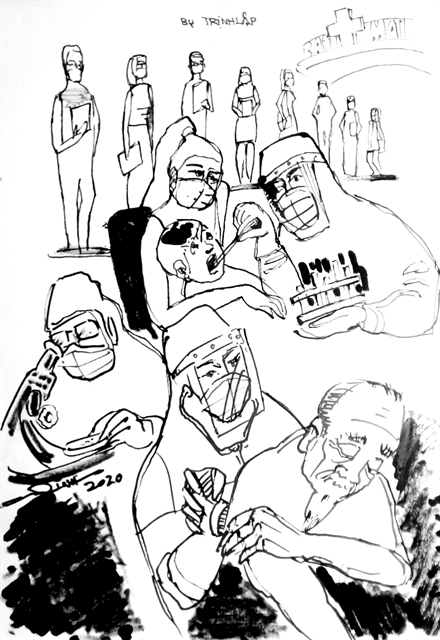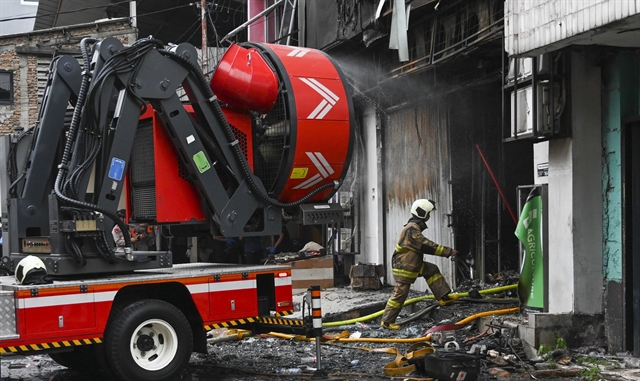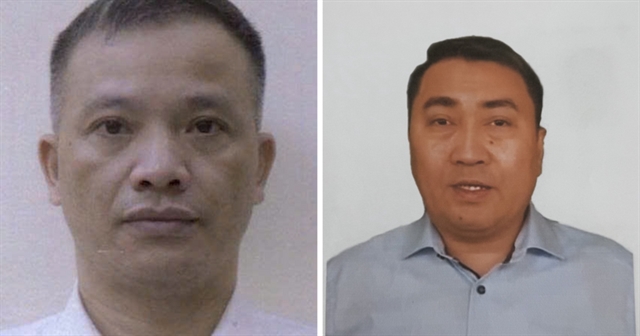 Talk Around Town
Talk Around Town


|
| Illustration by Trịnh Lập |
by Nguyễn Mỹ Hà
On August 6, patient No. 714, who travelled to Đà Nẵng from July 14-17, went to work on July 18.
The first new case of the community transmission for months was confirmed on July 25. The man who was to become patient No. 714 reported himself to health authorities on July 26. He was fast-tested negative on July 31 and moved through three hospitals before finally being tested with RT-PCR at the National Hospital for Tropical Diseases and confirmed a patient on August 5.
One day earlier, the Quảng Nam Health Department issued a decision on August 4 stopping the use of so-called fast-test kits for COVID-19 in the province, which has been among the hardest-hit by the latest outbreak in hospitals in nearby Đà Nẵng.
The fast-test kit, also known as the Elisa test, is a blood test checking antibody levels, which determine whether you have been infected with the coronavirus and your body developed antibodies to fight it. Scientists advise you take the test 14 days after last having contact with a possible source.
In the week since our last column, the number of people living in Hà Nội who recently spent time in Đà Nẵng has risen significantly.
On July 29, about 21,000 people stated in online health declarations that they had been to the popular central city not long ago, and by noon the next day it went up to 53,000 and is now at 94,000 as we go to print.
Initial efforts to contain such a large number of people returning from a pandemic-hit area have included self-quarantine and testing.
CDC Hà Nội has used Elisa test kits on nearly 70,000 people over the last few days, with only 12 positive results, which were all later tested by RT-PCR, which is currently the best way to determine if you have the SARS-CoV-2 virus, which causes COVID-19, and all gave negative results.
Many people took to social media to exclaim they had tested negative, which caused serious concern among scientists.
They warned that those who had negatives in the Elisa test still need to respect the 14-day self-quarantine. They must remain at home and not have any contact with anyone.
But Hà Nội has not made a similar decision. On August 2, at a meeting with city officials, Hà Nội authorities requested 20,000 additional Elisa kits to test all people who had declared since July 1 that they had visited Đà Nẵng just prior.
Such is the concern in the community that there have been reports of people registering for tests when just a single person from their circle of family and friends has visited the city.
Connected to the recent outbreak in Đà Nẵng, two cases in Hà Nội were detected by the RT-PCR method and confirmed by a swab of the nose and throat. One case was not showing any symptoms, but out of his own concern arranged for himself and his wife to be tested at the National Pasteur Institute in Hà Nội. He was named patient 459 soon after.
RT-PCR (Antigens) vs Elisa (Antibody) testing
What is an RT-PCR test and what does its result show? The COVID-19 RT-PCR (real-time reverse transcription-polymerase chain reaction) test qualitatively detects nucleic acid from SARS-CoV-2 in upper and lower respiratory samples, with mucus taken from the nose and throat.
Put more simply, the test checks for antigens -- molecules capable of stimulating an immune response once they detect a known virus. Theses antigens can be proteins, lipids or nucleic acids.
The RT-PCR test has proven to be the most accurate way of detecting COVID-19 currently available.
It does, however, at times give false positives or false negatives due to the number of antigens detected. This is why a person may test negative then test positive soon after, or vice-versa.
An antibody is a protein produced by B cells in the immune system to respond to the arrival of antigens. When a person is infected with SARS-CoV-2, the immune system produces antibodies to help eliminate the virus. This process can be harnessed to develop antibody and antigen-based diagnostic tests.
As this latest outbreak hit patients and staff at three major hospitals in Đà Nẵng during the height of the summer holidays, a large number of vacationers who returned home to other parts of the country now wonder if they had any close contact with the virus.
A massive testing process was therefore undertaken last weekend, with 53,000 plus people declaring they had returned home from the central city since July 1.
But it was a huge waste of time, with resources outlaid and effort spent by people who risked being infected by going to testing centres. It was also a waste of medical resources and the time of medical staff with already heavy schedules.
According to the website of the US Food and Drug Administration (USFDA), the Elisa test is used to detect antibodies in the human body.
When a virus enters the body, the body detects the invasion and develops antibodies to stave off the attack. The process can, however, take time. With the coronavirus, a person may be infected but not show any symptoms. The window period, when no symptoms are displayed, can last 14 days, according to the USFDA.
So the Elisa test is best for those who returned home between July 1 and 14. Those who were in Đà Nẵng after the 14th need to wait a little longer for any antibodies to be produced.
Many doctors, though, have gone on social media to warn people about properly understanding negative Elisa test results, saying they should still self-quarantine for 14 days to protect themselves and those close to them.
Another concern among medicos is that with a large number of people rushing to testing centres, the two-metre social distancing rule cannot always be respected and the fear is that some people may have unwittingly transmitted or even caught the virus while waiting to be tested.
What to do?
One patient was outraged in a Facebook post, saying: “I respected all the medical guidelines. I travelled only when domestic flights were reopened, and had a long-awaited break in this beautiful city that had been safe for 99 days straight. Why am I now a COVID-19 patient?”
He also asked the same question we’ve all been asking: What are the correct steps to follow to protect ourselves and our families?
What we can do is wash our hands, wear a face mask, and limit our travels to safe destinations only. What else would we like to be done?
We would like to have RT-PCR tests available on request! In Hà Nội you can’t just get an RT-PCR test by calling the CDC. Due to limited numbers you need a medical referral to be tested. According to CDC Hà Nội, they can test up to 2,000 samples a day. If more equipment was provided, they could conduct more tests.
Health officials have announced that this new outbreak is a totally new strain of the virus not recognised in the country before. As a result, there will be no social distancing measures throughout the country at this time.
This announcement was welcomed by the population, who are concerned the pandemic may hurt the economy to the point where recovery becomes impossible.
Scientists, meanwhile, have voiced their concern over the more lenient methods introduced compared to last time.
“This is like letting a load of chickens loose and then chasing after them,” wrote a regular commentator in a group jointly fighting COVID-19. Another wrote anonymously that the “golden” one-week period after the new cases were detected has now passed. “The number of people out there running around with the virus but exhibiting no symptoms could be much higher than believed. Other countries who acted late in the beginning still can’t get the situation under control.”
But the human factor, the driving force that helps put every effort together to fight this enemy, has been truly amazing.
When the outbreak first hit Đà Nẵng’s hospitals, the Government and the Ministry of Health offered immediate support by sending experienced doctors from around the country to provide consultations and training.
Việt Nam did so well back in April, when the country went through a social distancing period of three weeks.
Schools then re-opened, with students finishing their second semester just a month later than normal. Some families then had a long-awaited summer vacation.
It seemed that life was returning to its usual rhythm, and then the first of the new patients tested positive on July 24.
While everyone else around the country spent that six-week respite getting back to some semblance of normality, medical workers were treating patients coming back from overseas with COVID-19. The number rose ever-so-slowly, in the background of daily announcements proclaiming “no new community transmissions detected”.
But those days have ended. As a community, we can support our healthcare workers not only with words or songs or art but more practically by not adding to their workload. That’s also pretty good for us.
Sections of Đà Nẵng and Hội An have been sprayed by the army, and a 2,000-bed military field hospital has been set up in the city’s Tiên Sơn Sports Complex. The battle is underway.
If everyone respects social distancing measures, is tested correctly, and remains at home whenever possible, weeks from now we may see the benefits of today’s discipline and sacrifice.
Be strong, Việt Nam, keep up the good work! Together we shall overcome! VNS




